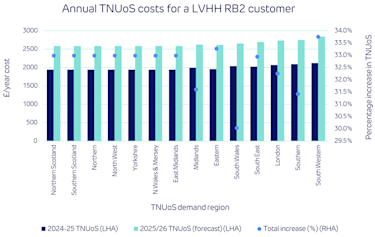Updated TNUoS forecast softens estimated tariff increases
National Grid Electricity System Operator (ESO) published its summer update of forecast Transmission Network Use of System (TNUoS) tariffs to apply for 2025/26, on 31 July.

Forecast tariff levels have seen an overall slight decrease since the initial forecast in April. In part, this is due to a 1.1% reduction in the amount of revenue to be recovered from demand users of the system. An updated site count forecast has driven some deviations from this average reduction.
Both the forecast half-hourly (HH) and non half-hourly (NHH) average tariffs have also fallen. The ESO reports that the average HH gross tariff forecast has reduced £1.13/kW to £6.64/kW and the average NHH tariff is forecast to dip 0.07p/kWh to 0.30p/kWh.
However, there’s a significant amount of regional variation to these movements. For example, HH tariffs in the South West region were expecting a 42% rise year-on-year based on the April forecasts. This has now shifted to a 50% reduction. In South Wales, the trend is reversed with the forecast reduction in 2025 altering to a 56% increase. This is due to relative levels of generation forecast in each region; the ESO expects 2GW of additional generation in the South West and 0.5GW less in South Wales.
Adding both the residual fixed charge and the HH tariff for a representative Low Voltage Site Specific (LVSS) Residual Band 2 customer (based on an average 22kW demand over the triad periods), the forecast tariff ranges between £2,548/year and £2,714/year. This compares to between £2,584/year and £2,840/year in the April forecast.
While the forecast tariffs have decreased slightly, they remain significantly higher than tariffs in 2024-25. Taking the arithmetic average across regions, for a typical LVSS customer, the average tariff is expected to increase by 30.4% based on the latest forecast (see Figure 1). This is 2.2 percentage points lower than the average 32.6% expected in the April forecast.

This is the second forecast for the coming charging year, ahead of the ESO publishing draft tariffs in November, then issuing final tariffs for the charging year in January 2025.
Disclaimer
We’ve used all reasonable efforts to ensure that the content in this article is accurate, current, and complete at the date of publication. However, we make no express or implied representations or warranties regarding its accuracy, currency or completeness. We cannot accept any responsibility (to the extent permitted by law) for any loss arising directly or indirectly from the use of any content in this article, or any action taken in relying upon it.



